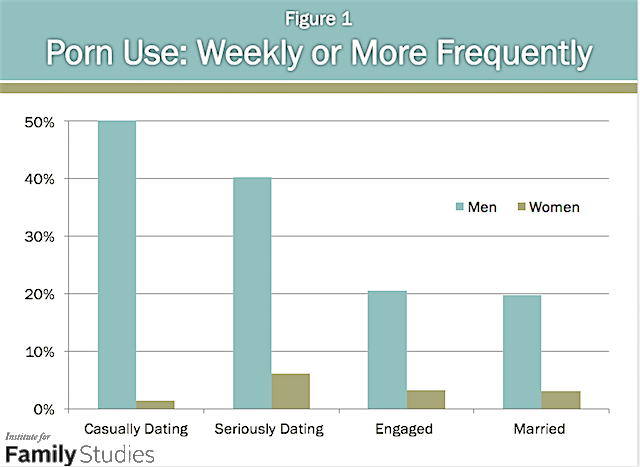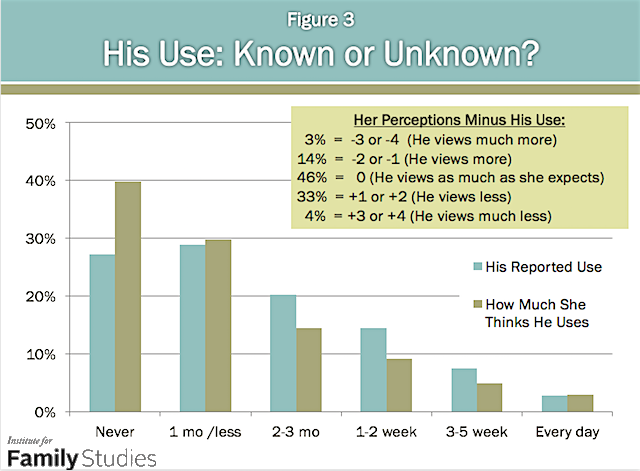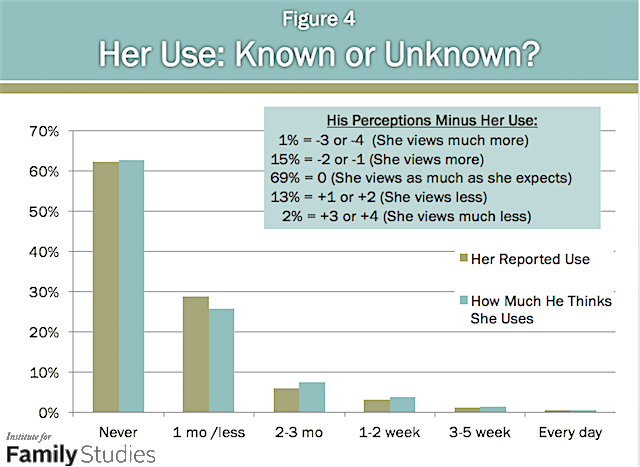Highlights
Perhaps the most consistent finding of pornography studies to date is that there is a sizeable gap that exists between men and women when it comes to their personal use and acceptance of pornography. Dozens of studies have shown that men are more likely than women to view pornography, and this is particularly true of viewing pornography regularly on a daily or weekly basis.
This “porn gap” raises a number of questions about dating patterns and the relationship dynamics that arise between men and women related to pornography use, such as:
- What happens to men’s and women’s pornography patterns when they enter committed romantic relationships?
- Do men decrease or stop their pornography use as they enter into committed romantic relationships?
- Do men keep using pornography, but hide it from their partners?
- Do women start or increase their use of pornography when they become romantically involved with a man who uses pornography?
- Does a new pattern of pornography use emerge during the coupling process that shifts from individual use to couple use?
The answers to these questions are not well understood in the pornography and couple formation literature. In all likelihood, the answers differ from couple to couple. The patterns that emerge as couples navigate these issues surrounding pornography use likely influence future couple patterns and outcomes—for better or for worse.
In this research brief, we summarize the findings from a study we recently published that examines romantic partners’ pornography use rates, patterns of viewing pornography alone or together, relationship boundaries related to pornography acceptance, and pornography-related conflict among committed couples. We used a nationally representative sample of individuals who are in committed heterosexual couple relationships and a subset of almost 1,500 matched heterosexual couples.1
Data and Methods
The study examined pornography use rates, patterns of viewing pornography alone or as a couple, partners’ values related to pornography, and the frequency of pornography as an area of conflict in couple relationships. Two of the main research questions we sought to answer included:
- What are men and women’s pornography patterns at different stages of relationship commitment?
- How aware are partners at different stages of relationship commitment of their partner’s pornography use?
The study involved two samples, both of which came from participants who completed the RELATE Questionnaire (Busby, Holman, & Taniguchi, 2001)2 during 2011–2013. The primary sample consisted of an individual data set that was weighted to be as close as possible to census norms in terms of gender, race, religion, and education. It consisted of 21,555 participants who reported they were in a casually dating (n= 655), serious dating (n=6,167), engaged (n=8,720), or married (n=6,013) heterosexual relationship.
The second sample was used to answer our second research question and consisted of a matched heterosexual couple data set, where both partners completed RELATE and indicated that they were in a serious dating, engaged, or married heterosexual relationship (only committed couples are a part of the matched couple data set). These selection criteria resulted in a sample of 1,486 couples where 23% were seriously dating, 57% were engaged, and 20% were married (see the full study for a full description of the samples used).
Pornography Patterns at Different Stages of Commitment
Pornography Use. When it comes to pornography use, there appears to be a difference between men and women across relationship commitment levels. When compared to men on the basic pattern of pornography use, women were about twice as likely to report that they “never” use pornography as men in the same level of commitment. The percent reporting “never” on personal pornography use were:
- 57% of casually dating women vs. 25% casually dating men
- 60% of seriously dating women vs. 25% of seriously dating men
- 61% of engaged women vs. 38% of engaged men
- 65% of married women vs. 37% married men
The pornography gap deepens extensively, however, when the frequency of pornography use is examined—with casually dating men being 42 times more likely to report viewing pornography at least weekly or more than casually dating women. While men’s pornography use was substantially less in more committed relationships—with a nearly 50% difference in the level of frequent use between dating men and engaged or married men—we found a consistent pattern of many women who report little or no use being partnered with men who regularly use pornography (see Figure 1).

Together or Alone? Furthermore, it appears that many of the couples who have similar pornography use patterns are those in which both partners refrain from using pornography. On the other hand, as individuals who use pornography enter into couple relationships, the question arises as to whether they view pornography alone or together as a couple. We found a similar pattern of together versus alone use across relationship types.
Specifically, we found that men across relationship types who view pornography are about three to four times more likely to report viewing pornography always alone (i.e., 100% alone, 0% with a partner) compared with women in similar relationships who view pornography. The percent reporting that the view porn “always alone” were:
- 45% of casually dating men vs. 13% of casually dating women
- 49% of seriously dating men vs. 15% of seriously dating women
- 47% of engaged men vs. 14% of engaged women
- 45% of married men vs. 11% of married women
As noted in Figure 2, women who view pornography were about three to four times more likely to report a pattern of use that was primarily or completely couple-based in viewing pornography together with their partner (i.e., 25% alone, 75% with a partner or 0% alone, 100% with a partner). When coupled with the finding that approximately 60% of women in all relationships types reported never viewing pornography, this means that approximately 70 to 80% of women reported either not viewing pornography at all or have a pattern of only using porn with a partner.

Pornography Acceptance and Conflict. In terms of pornography acceptance, it is clear that pornography is a debated topic across relationship types, with anywhere between one-third to one-half of both men and women in our sample expressing disapproval of pornography depending on which value question is examined. Nearly one-third of engaged and married women reported that they view pornography as a form of “marital infidelity,” and a sizeable portion of men and women (between 35% and 52%) agree that pornography “objectifies and degrades.”
In engagement and marriage, approximately 1-in-5 partners believe that pornography use is only acceptable when it is viewed together. With regard to conflict about pornography, a portion of individuals in all couple commitment types reported that they agreed that pornography had been a source of conflict in their relationship. A notably high amount of casually dating men (45%) reported that pornography had been a problem in their relationship. This is striking given that this is the relationship type where women seem to misjudge the amount of high pornography use among their partners. Perhaps dating men sense that the women they are starting to date often disapprove of frequent pornography use, and they are worried about it being a problem, even before their partner knows about it. For committed couples, less than 10% of partners in seriously dating relationships reported pornography conflict; whereas between 1-in-8 to nearly 1-in-5 engaged and married partners reported that pornography had created conflict in their relationships.
How Aware Are Individuals of a Partner’s Pornography Use?
The amount of awareness that romantic partners have about each other’s pornography use is one of the most critical, yet understudied, relationship dynamics of pornography in couple relationships. In our study, the number of women that reported that their partner was not using pornography was notably higher than the number of men reporting no use in the corresponding relationship commitment type. Again, these differences are substantially greater when frequency reports are examined.
For example, only 4% of women in casually dating relationships reported that their partner uses pornography weekly or more often, but 50% (13 times as many) of casually dating men reported weekly or more frequent use. In fact, none of the casually dating women reported that their partner uses pornography almost daily or every other day, but 43% of casually dating men in our sample reported this level of heavy use.
How aware are individuals regarding their partner’s pornography use? To obtain a baseline understanding of pornography awareness between partners, we collapsed all relationship commitment types and then subtracted each partner’s reported level of pornography use from their partner’s perception of their use.
For women (see Figure 3), there was only a 46% congruent awareness level where their male partner reported using pornography at the same level she reported; with 37% of men reporting more pornography use than she was aware of, and 17% reporting less use than she believed was occurring.

For men (see Figure 4), there was a 69% congruent awareness level of their female partner’s pornography use, with only 16% of female partners using pornography more than he knew and 15% using less than he perceived. Much of the higher level of congruent awareness for men of their female partner’s use came from the fact that more than 60% accurately reported that their partner never uses pornography.

The Porn Gap and Relationships
The findings reported in this research brief confirm and extend other studies that have found that there is a persistent difference in pornography patterns between men and women across relationship commitment levels. While these differences may have little or no practical significance for some couples, emerging research suggests that discrepancies in pornography use at the couple level are related to negative couple outcomes. Specifically, in one of our previous studies (see Willoughby et al, 2016), we found that pornography differences may harm specific couple interaction processes such as communication and sexual desire, which, in turn, may negatively influence relationship satisfaction and stability.3
The findings of this study also support our previous claim that the amount of awareness that romantic partners have about each other’s pornography use is likely one of the most critical, yet understudied, aspects of pornography use in couple relationships. While scholars continue to debate the direct consequences of pornography use on individuals’ attitudes and behaviors, pornography concealment may be an equally critical variable. Research suggests that patterns of concealment in close relationships contribute to feelings of exclusion, reduced trust, and increased conflict, which, in turn, negatively affect relationship outcomes.
Pornography acceptance and conflict are connected with awareness patterns in couple relationships, although the exact relationship between these processes is not well understood. We found that as much as one-half of women in romantic relationships disapproved of pornography to some degree and that nearly one-third of engaged and married women considered pornography a form of marital infidelity. These findings are particularly noteworthy given that it appears that in early couple formation, many women may have little understanding of how often their male counterparts view pornography.
As much as one-half of women in romantic relationships disapproved of pornography to some degree and that nearly one-third of engaged and married women considered pornography a form of marital infidelity.
This level of a gap also calls into question what behaviors women are referring to when they report whether they find pornography use acceptable. Are they envisioning the infrequent dabbling that is present among their female peers or the habitual use patterns common among the men available in their dating circles? Are there certain types of pornography content these women view as more or less acceptable for their male partners? These patterns deserve further investigation.
Implications for Couples
When pornography is viewed as a part of a couple relationship, rather than simply a personal behavior, couples are better equipped to explore the fuller meanings of pornography in their relationship. It is important for couples to discuss several aspects of pornography, especially what pornography means to each partner and how pornography use may influence their feelings of trust and attachment with each other. It’s also important for couples to set mutually agreed-on boundaries in their relationship.
Relationship satisfaction is a result of partners developing a secure attachment with each other, where each partner trusts that the other will be physically, emotionally, and psychologically responsive to his or her needs. Behaviors that are interpreted as disrupting or eroding this trust could have a significant negative impact on couple communication, intimacy, and satisfaction. Scholars and therapists have noted that partner differences in pornography use and acceptance may influence the partners’ sense of trustworthiness and security in the relationship (Butler & Seedall, 2006).4 As Zitzman and Butler (2009) explain:5
Pornography scripts expectations and behavior that place it on a collision course with the requisite dynamics for secure attachment and authentic intimacy in the pair-bond relationship … the detached, objectifying, exploitive sexuality of pornography directly impacts attachment trust, eroding any safe expectation of one’s partner being faithfully for the other.
If a partner sees pornography as an untrustworthy act that turns her or his partner’s attraction toward others or as an indicator that he or she approaches sex from a self-centered, rather than an other-centered orientation, the partner’s sense of security will likely diminish in the relationship.
However, as we have described in our previous research, the “structure of security” in pair-bond relationships may be somewhat subjective and can vary from relationship to relationship (see Willoughby et al, 2016).6 Differences in pornography use and acceptance will likely influence whether pornography is seen as a violation of relationship trust or attachment threat, thus influencing overall relationship satisfaction. Couples need to explore the trust and attachment issues “behind the behaviors,” so to speak, to see if such discrepancies have created attachment threats or injuries. Our current study’s findings suggest that couples should discuss several different aspects of pornography, including use, acceptance, and concealment.
Perhaps the most significant, yet difficult dynamic to address as a couple is pornography concealment or the degree that partners are open with each other about their frequency, duration, and content of pornography viewing. While scholars continue to investigate the effects of pornography use for individuals and couples, one significant way that pornography harms relationships is that it often happens in secret. As our study suggests, many users of pornography typically hide, or at least minimize, their use of pornography from everyone, including their romantic partners.
If this pattern develops, there are two critical threats to the relationships. First, when people engage in this type of self-concealment, it not only often hurts their relationships and leaves them feeling lonely, but also makes them more vulnerable to depression, poor self-esteem, and anxiety. Also, when romantic partners keep secrets from each other, their trust in each other erodes and their confidence in their relationships starts to struggle.
Jason S. Carroll, Ph.D. is a professor in the School of Family Life at Brigham Young University and a Fellow of the Wheatley Institution. Dr. Carroll recently received the Berscheid-Hatfield Award for Distinguished Mid-Career Achievement from the International Association for Relationship Research. Brian J. Willoughby, Ph.D. is an associate professor in the School of Family Life at Brigham Young University and an international expert in the field of couple and marital relationships, sexuality, and emerging adult development.
Editor’s Note: The views and opinions expressed in this article are those of the author and do not necessarily reflect the official policy or views of the Institute for Family Studies.
1. Carroll, J. S., Busby, D. M., Willoughby, B. J., & Brown, C. (2017). The Porn Gap: Differences in Men’s and Women’s Pornography Patterns in Couple Relationships. Journal of Couple and Relationship Therapy, 16 (2), 146-163.
2. Busby, D. M., Holman, T. B., & Taniguchi, N. (2001). RELATE: Relationship evaluation of the individual, family, cultural, and couple contexts. Family Relations, 50, 308–316.
3. Willoughby, B. J., Carroll, J. S., Busby, D. M., & Brown, C. (2016). Differences in pornography use among couples: Associations with satisfaction, stability, and relationship processes. Archives of Sexual Behavior, 45, 145–148.
4. Butler, M. H., & Seedall, R. B. (2006). The attachment relationship in recovery from addiction. Part 1: Relationship mediation. Sexual Addiction & Compulsivity, 13, 289–315.
5. Zitzman, S. T., & Butler, M. H. (2009). Wives' experience of husbands' pornography use and concomitant deception as an attachment threat in the adult pair-bond relationship. Sexual Addiction & Compulsivity, 16, 210–240
6. Willoughby, B. J., Carroll, J. S., Busby, D. M., & Brown, C. (2016). Differences in pornography use among couples: Associations with satisfaction, stability, and relationship processes. Archives of Sexual Behavior, 45, 145–148.














